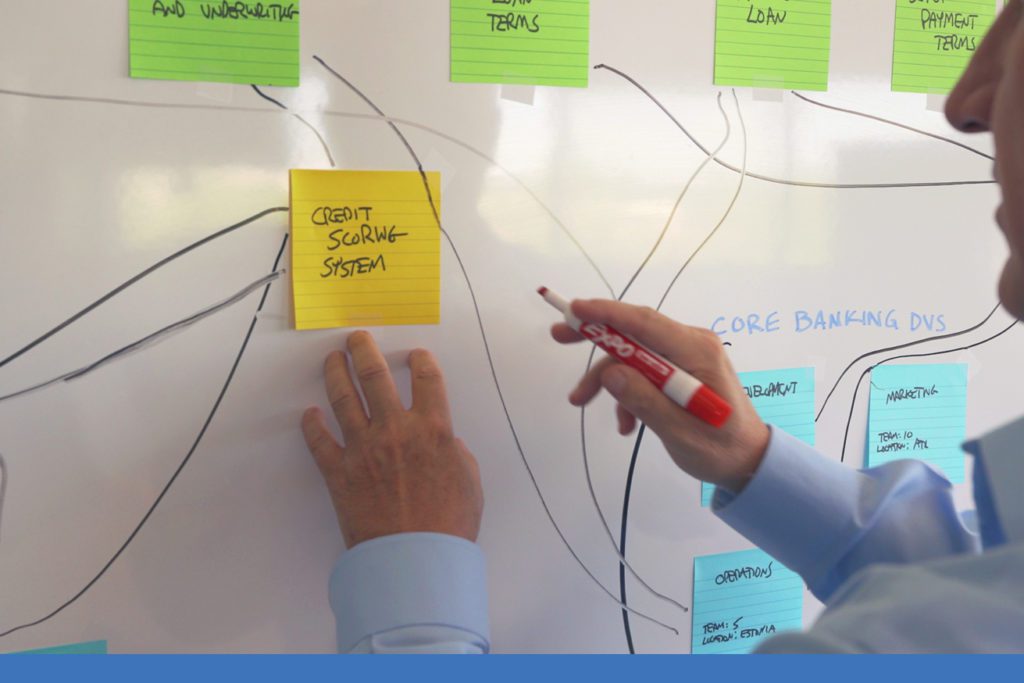
Organizing Around Value
Lots of organizations are organized around functional silos—such as business, system engineering, hardware, software, testing/QA, and operations. These structures exist because they support specialization and allow organizations to grow and manage their people effectively. It’s why so many organizations are set up in this way. And many organizations persist in this siloed structure even when they start their journey toward business agility.
For example, they create Agile teams that map to specialized components or subsystems. Similarly, they create Agile Release Trains around entire departments or functions. From a change management perspective, it’s easier to keep the current structure and apply Agile ways of working on top of it. But value doesn’t flow in silos. In many cases, these so-called Agile teams or teams of teams struggle to deliver valuable increments because what’s valuable requires collaboration across the silos. Additionally, teams struggle to see how their work builds up to something valuable for the customer.
Business agility and digital transformation are all about speed of learning and value creation in the face of a dynamic changing environment. The classic organizational structure isn’t optimized for this speed, which is why SAFe® introduces the value stream network as part of a dual operating system that runs parallel to the organizational hierarchy.
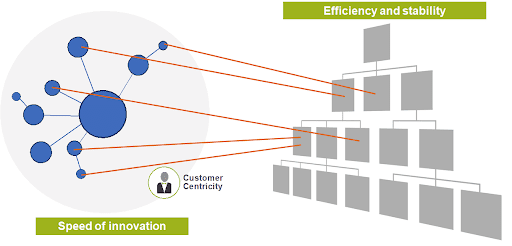
Development value streams (DVDs) are the organizational construct used by SAFe to create this value stream network. DVDs are where the essential activities of defining, implementing, and supporting innovative, digitally enabled solutions occur. Defined correctly, DVDs are able to deliver valuable business solutions on their own with minimal dependencies on other parts of the business.
Alongside the DVDs are Operational Value Streams (OVSs) which describe the steps needed to deliver value to the organization’s customers. Examples might include providing a consumer loan or provisioning a software product. With this in mind, the DVS has one purpose: to create profitable OVSs. They do this either by creating the systems that the OVS relies on to operate effectively or by building the products that the OVS sells. With this in mind, understanding how the work is done in the OVSs helps us understand what value looks like, how it flows from demand to delivery in our context, and how we might organize our DVDs to support this.
What’s the Right Approach to Defining Operational Value Streams?
Identifying the OVS is a relatively straightforward exercise for a technology/development organization trying to organize effectively around the value that the wider organization is delivering to customers. People supporting systems that are used when providing these services (digital or physical) can easily apply customer-centric thinking and identify an OVS oriented around the needs of the real external customer.

It gets tougher to map an OVS when you’re a vendor selling your product/solution for use as part of another organization’s operational activities. A great example is an independent software vendor (ISV). Other examples include vendors building and selling cyber-physical systems such as medical devices and manufacturing equipment.
Consider vendor ACME Corp, which provides banks and financial institutions with banking systems. ACME Corp is building an AI-powered loan underwriting system that will fit into their banking systems portfolio. What OVS should ACME Corp model when considering how it might organize around value?
Many SAFe practitioners would suggest that ACME Corp model an OVS that focuses on how it would market, sell, and operate its solution.

Vendor IT folks supporting systems like CRM and ERP find it a useful way to model the business process they’re supporting. With this OVS in mind, they can make sure they organize around the whole buyer journey. And they can apply systems thinking to explore what features to introduce to the systems supporting this process.
The problem with this approach is that this OVS is mainly from the vendor and buyer journey perspectives. It doesn’t provide any information on how the solution will be used or the kind of work that it will support. An alternative approach is to use the real customer’s experience/journey as the OVS. Basically, take the same perspective that an internal technology organization would when building systems for these customers.
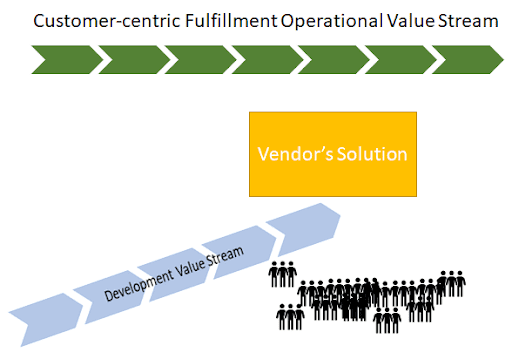
Both the buyer journey OVS and customer-centric journey OVS exist. The question is: which of them is more useful to focus on? Remember that we map OVSs in order to build a hypothesis around what’s an effective DVS. In this example, both OVS perspectives can be useful.
The customer-centric fulfilment OVS focusing on the solution context within which the ISVs product lives are the perspective that product development/engineering should focus on—this is where the systems/products/solutions that they create exist. This perspective would be more relevant to people building the products the vendor is selling because it would get them closer to their customers. It would also help them apply systems thinking to which features can really support generating value for these customers and for the enterprise serving these customers.

Emphasize Customer Centricity as Part of Value Stream Identification
The example above illustrates why vendors can find it daunting to figure out which OVS to focus on. Going down the software product OVS perspective often leads to confusion and lack of guidance because it’s disconnected from how the products are used and from the solution context. A common move vendors make at this point is to fall back to organizing around products. Being able to explore, build, deploy, release, and operate/maintain a product can be a significant improvement for some organizations.
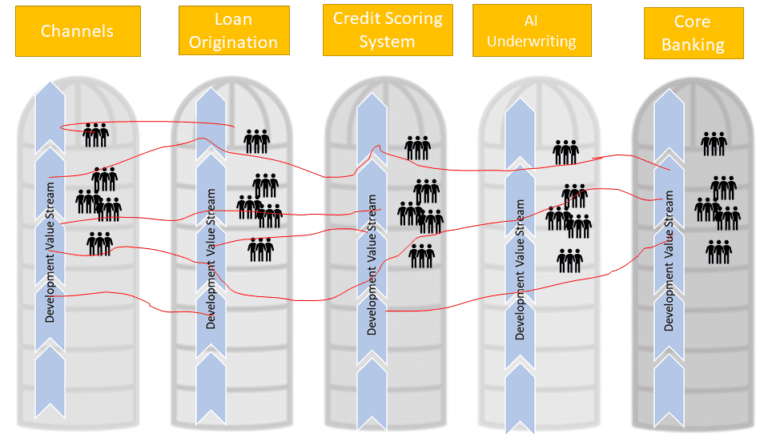
The problem with this structure is that it still has silos. And once we look at the value the vendor is trying to create, we might see a lot of dependencies between these silos. The management challenge is to connect the right silos—those that need to collaborate to deliver the value that the organization’s strategy is pointing toward.
Leveraging customer centricity using the customer’s fulfilment OVS can help the vendor transcend product silos and maximize the value created by their product portfolio. More vendors we work with that started with ARTs and DVDs oriented around products find themselves with heavy coordination overhead across different DVDs and ARTs when executing on strategic themes and portfolio initiatives.
Going back to our AI-powered underwriting product actually supports multiple steps in the customer-centric OVS, and requires new features across a range of the vendor’s products. Maximizing the value of AI-powered underwriting requires collaboration and coordination with the groups developing these products. If all of these different products are built by different DVSs, this coordination will be slow and painful. If the vendor organizes around value and brings the right people with the ability to get AI-powered underwriting integrated into the different products, time-to-market and quality will be improved. People would also feel more motivated and engaged since they’re very focused and effective.
Using a customer-centric OVS is key to understanding your real solution’s context. This can enable you to organize effectively to minimize dependencies and enable collaborations that streamline the customer journey. Which is essentially the goal of most products—to help a business better serve its customers.
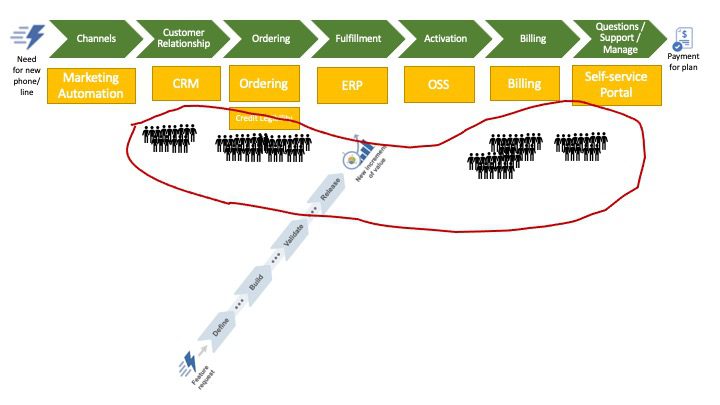
When a DVS is created to support a customer-centric OVS, the organization can use techniques including value stream mapping and design thinking to innovate “in the Gemba—where the real value flows.” When this DVS includes everyone needed to explore, build, deploy, and support solutions that cut across the customer-centric OVS, we’ve truly created a network operating system that’s organized around value. And we’ve taken a huge step toward enabling real business agility.
Join our webinar on June 9, 2021 with SAFe Fellow Andrew Sales. You’ll learn tactical advice and tips to identify operational and development value streams that help optimize business outcomes. We hope to see you there!
About Yuval Yeret

Yuval Yeret is the head of AgileSparks (a Scaled Agile Partner) in the United States where he leads enterprise-level Agile implementations. He’s also the steward of The AgileSparks Way and the firm’s SAFe, Flow/Kanban, and Agile Marketing. Yuval is a SAFe Program Consultant Trainer (SPCT5), a Professional Scrum.org Trainer (PST), an internationally recognized Kanban Trainer, a thought leader, recipient of the Lean/Kanban Brickell Key Award, and a frequent speaker at industry conferences.
Share:
Back to: All Blog Posts
Next: Winning the Customer with Experience Architecture